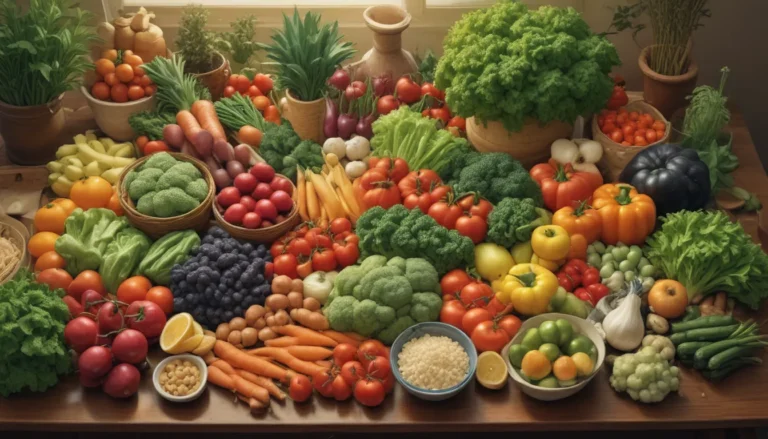The Ultimate Guide to Growing, Eating, and Healing with Mediterranean Herbs

Are you looking to elevate your gardening game and add some culinary delights to your kitchen? Well, look no further than the top five Mediterranean herbs: Basil, Oregano, Rosemary, Sage, and Thyme. These classic Italian-style herbs are not only easy to grow but also pack a punch when it comes to flavor and healing properties.
Why Choose Mediterranean Herbs?
By selecting these common herbs for your garden, you are not only ensuring that you have fresh seasonings readily available, but you are also tapping into centuries-old traditions of culinary and medicinal use. These herbs have been essential in Italian, Greek, Middle-eastern, and Northern African cuisines, as well as folk medicine practices.
Basil (Ocimum basilicum)
Basil, known for its distinct aroma and flavor, is a versatile herb used in cuisines around the world. Whether you’re making pesto, pasta sauces, or salads, basil adds a fresh and aromatic touch to any dish.
Growing: Basil thrives in warm temperatures and requires plenty of sunlight. Starting basil from seeds or cuttings is relatively straightforward, but it’s essential to provide the right conditions for optimum growth.
Cooking: Basil pairs excellently with tomatoes, cheese, meats, vegetables, and pasta dishes. Get creative with your basil use and explore its versatility in various recipes.
Healing: Basil has been associated with stress relief, asthma management, and even diabetes support. Research indicates its potential antimicrobial and cancer-fighting properties.
Oregano (Origanum vulgare)
Oregano, with its robust and zesty flavor, is a staple in Italian cuisine. This herb also offers a range of health benefits, making it a valuable addition to your garden and kitchen.
Growing: Oregano prefers hot weather and bright sunlight. Selecting the right variety for your climate is crucial to its success. Starting oregano from seeds or cuttings requires attention to soil conditions and watering habits.
Cooking: Oregano is a must-have herb for pasta dishes, pizzas, vegetables, meats, and Greek-inspired cuisine. Experiment with different flavor combinations to make the most of this versatile herb.
Healing: Oregano has been used traditionally for digestive, respiratory, and hormonal imbalances. Studies suggest its antibacterial, antifungal, and anti-cancer properties, highlighting its potential health benefits.
Rosemary (Rosmarinus officinalis)
Rosemary, known for its pine-like aroma and earthy flavor, is a hardy herb that adds a unique dimension to dishes. Whether you’re roasting meats, baking bread, or enhancing sauces, rosemary is a kitchen essential.
Growing: Rosemary thrives in warm climates but requires protection in colder regions. Proper soil drainage, sunlight exposure, and watering practices are essential for rosemary’s growth and health.
Cooking: Rosemary complements a wide range of foods, including meats, vegetables, bread, and cheeses. Its versatile flavor profile makes it a popular choice for various culinary applications.
Healing: Rosemary has been historically used for nervous issues, digestive problems, and food preservation. Studies suggest its antioxidant properties, antimicrobial effects, and potential benefits for Alzheimer’s disease and diabetes prevention.
Sage (Salvia officinalis)
Sage, with its earthy and slightly peppery taste, is a herb with a rich history of culinary and medicinal use. From savory dishes to herbal remedies, sage offers a range of benefits for both cooking and healing.
Growing: Sage is relatively easy to grow and thrives in full sun with well-draining soil. Proper watering and winter care are crucial for sage’s long-term health and productivity.
Cooking: Sage is a versatile herb that pairs well with meats, vegetables, bread, and cheeses. Its distinct flavor adds depth to various dishes, making it a valuable ingredient in your culinary repertoire.
Healing: Sage has been traditionally used for colds, flu, fever, and digestive issues. Recent studies highlight its antimicrobial, antioxidant, and anti-cancer properties, showcasing its potential health benefits.
Thyme (Thymus vulgaris)
Thyme, a petite yet powerful herb, is native to the Mediterranean region and offers a subtle yet distinctive flavor to dishes. From soups and stews to meats and vegetables, thyme is a versatile herb that enhances the taste of many recipes.
Growing: Thyme thrives in warm climates with well-draining soil and sunlight. Starting thyme from seeds, cuttings, or root divisions requires attention to watering and soil conditions for successful growth.
Cooking: Thyme is a common herb in Italian blends and pairs well with a wide range of foods, including vegetables, meats, cheeses, and bread. Its adaptable flavor profile makes it an essential ingredient in diverse culinary creations.
Healing: Thyme has a long history of use in herbal medicine for infections, colds, flu, and digestive issues. Research supports its antimicrobial, antioxidant, and potential cancer-preventing properties, highlighting its therapeutic benefits.
Conclusion
Incorporating Mediterranean herbs into your garden, kitchen, and healing practices can elevate your culinary creations and promote overall well-being. Whether you’re a novice gardener or an experienced herbalist, these five herbs offer a fantastic starting point for exploring the world of herbs for growing, eating, and healing. So plant, cook, and heal with these Mediterranean delights, and enjoy the bountiful benefits they offer in your daily life.





